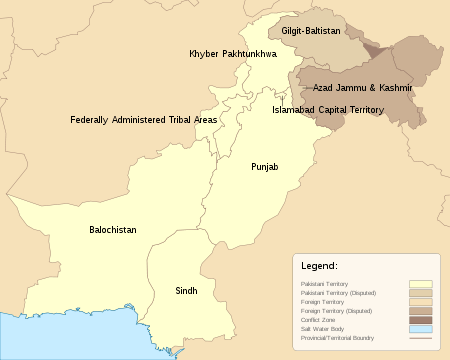One Unit

The One Unit (Urdu: ون یونٹ) was a geopolitical program launched by the government of Pakistan led by then-Prime Minister Muhammad Ali Bogra on 22 November 1954. The program was believed to be enacted after the government faced difficulty of administrating the two unequal polities of Pakistan separated from each other by more than a thousand miles.[1] To diminish the differences between the two regions, the program merged the Four Provinces of West Pakistan into a single province as was the case with East Pakistan (now Bangladesh).
Pakistani scholars and researchers maintain that the One Unit program was viewed as a counterbalance against the political and population domination of the ethnic Bengali population of East Pakistan. The One Unit program was met with great resistance and grievances from the Four Provinces since its establishment, and it remained in effect until 1970.[1] Finally, President General Yahya Khan imposed Legal Framework Order No. 1970 to end the One Unit program and reinstate the provisional status of the Four Provinces as of August 1947.[1]
History of 'One Unit Scheme'
Although Pakistan was conceived by philosopher Sir Muhammad Iqbal in 1930 (uniting the four states of North-West British India), the country was established on 14 August 1947, directly resulting from the Pakistan Movement led by Muhammad Ali Jinnah. Since then, the country had been without a consolidated written constitution, and all Pakistan's state affairs had been run under constitutional acts of the British Indian Empire, such as the Government of India Act 1935 and the Indian Independence Act 1947. The Government had prolonged difficulty in administrating East Bengal, with its border with Eastern India, and the four provinces, which border Western India, Iran, China, and Afghanistan.
The Punjabi Prime Minister Chaudhry Muhammad Ali implemented the framework of the One Unit program on 14 October 1955 after Pakistan National Assembly passed a bill merging all of West Pakistan into a single province on 30 September 1955.Before this,his predecessor Prime Minister Mohammad Ali Bogra had made the first official announcement on 22 November 1954 about it. Rationalizing the framework, Bogra enumerated the benefits of having one unit or province.
"There will be no Bengalis, no Punjabis, no Sindhis, no Pathans, no Balochis, no Bahawalpuris, no Khairpuris. The disappearance of these groups will strengthen the integrity of Pakistan." (A comment made by Mohammad Ali Bogra in 1954.)[2]
1. It would end the curse of provincial prejudices.
2. It would allow the development of backward areas.
3. It would reduce administrative expenses.
4. It would make it easier to draw up a new constitution.
5. It would give East and West Pakistan maximum autonomy."
(The reasons given to the Assembly for adopting the One Unit Scheme by Iskander Mirza in September 1955.)[3]
After the 1954 general election, the four provinces and Tribal Areas were merged in the western wing. The province was composed of twelve divisions and the provincial capital was established at Lahore. The province of East Bengal (now Bangladesh) was renamed East Pakistan with the provincial capital at Dacca. The federal government moved the country's capital in 1958 from Karachi to Rawalpindi (serving as provisional capital until Islamabad was ready), while the federal legislature moved to Dacca.
West Pakistan formed a single and united political entity but with marked linguistic and ethnic distinctions. The One Unit policy was regarded as an administrative reform that would reduce expenditure and help eliminate ethnic and parochial prejudices. However, with the military coup of 1958, trouble loomed for the province when the office of Chief Minister was abolished and the President claimed executive power over West Pakistan. The province of West Pakistan was dissolved on 1 July 1970 by President General Yahya Khan.
Criticisms
Ethno-nationalists were against the unity and amalgamation of the federating units (the many princely states and provinces of the western wing) as West Pakistan. The actual author of the plan is alleged to be General (and later President) Ayub Khan.
See also
- Establishment
References
- Formation of One Unit , storyofpakistan.com website, West Pakistan Established as 'One Unit' province on 30 Sept.1955, Retrieved 16 August 2015